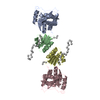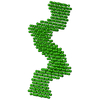+Search query
-Structure paper
| Title | The CD27L and CTP1L endolysins targeting Clostridia contain a built-in trigger and release factor. |
|---|---|
| Journal, issue, pages | PLoS Pathog, Vol. 10, Issue 7, Page e1004228, Year 2014 |
| Publish date | Jul 24, 2014 |
 Authors Authors | Matthew Dunne / Haydyn D T Mertens / Vasiliki Garefalaki / Cy M Jeffries / Andrew Thompson / Edward A Lemke / Dmitri I Svergun / Melinda J Mayer / Arjan Narbad / Rob Meijers /    |
| PubMed Abstract | The bacteriophage ΦCD27 is capable of lysing Clostridium difficile, a pathogenic bacterium that is a major cause for nosocomial infection. A recombinant CD27L endolysin lyses C. difficile in vitro, ...The bacteriophage ΦCD27 is capable of lysing Clostridium difficile, a pathogenic bacterium that is a major cause for nosocomial infection. A recombinant CD27L endolysin lyses C. difficile in vitro, and represents a promising alternative as a bactericide. To better understand the lysis mechanism, we have determined the crystal structure of an autoproteolytic fragment of the CD27L endolysin. The structure covers the C-terminal domain of the endolysin, and represents a novel fold that is identified in a number of lysins that target Clostridia bacteria. The structure indicates endolysin cleavage occurs at the stem of the linker connecting the catalytic domain with the C-terminal domain. We also solved the crystal structure of the C-terminal domain of a slow cleaving mutant of the CTP1L endolysin that targets C. tyrobutyricum. Two distinct dimerization modes are observed in the crystal structures for both endolysins, despite a sequence identity of only 22% between the domains. The dimers are validated to be present for the full length protein in solution by right angle light scattering, small angle X-ray scattering and cross-linking experiments using the cross-linking amino acid p-benzoyl-L-phenylalanine (pBpa). Mutagenesis on residues contributing to the dimer interfaces indicates that there is a link between the dimerization modes and the autocleavage mechanism. We show that for the CTP1L endolysin, there is a reduction in lysis efficiency that is proportional to the cleavage efficiency. We propose a model for endolysin triggering, where the extended dimer presents the inactive state, and a switch to the side-by-side dimer triggers the cleavage of the C-terminal domain. This leads to the release of the catalytic portion of the endolysin, enabling the efficient digestion of the bacterial cell wall. |
 External links External links |  PLoS Pathog / PLoS Pathog /  PubMed:25058163 / PubMed:25058163 /  PubMed Central PubMed Central |
| Methods | SAS (X-ray synchrotron) / X-ray diffraction |
| Resolution | 2.11 - 2.24 Å |
| Structure data |  SASDAL5:  SASDAM5:  PDB-4cu2:  PDB-4cu5: |
| Chemicals |  ChemComp-HOH: |
| Source |
|
 Keywords Keywords | HYDROLASE / BACTERIAL LYSIS / AUTOPROTEOLYSIS / BACTERIOPHAGE |
 Movie
Movie Controller
Controller Structure viewers
Structure viewers About Yorodumi Papers
About Yorodumi Papers



 Clostridioides difficile (bacteria)
Clostridioides difficile (bacteria) clostridium phage phictp1 (virus)
clostridium phage phictp1 (virus)